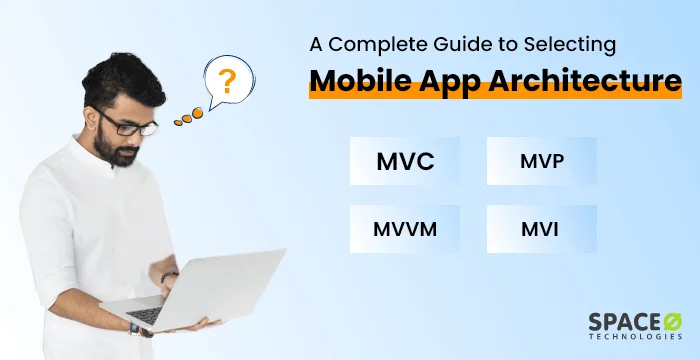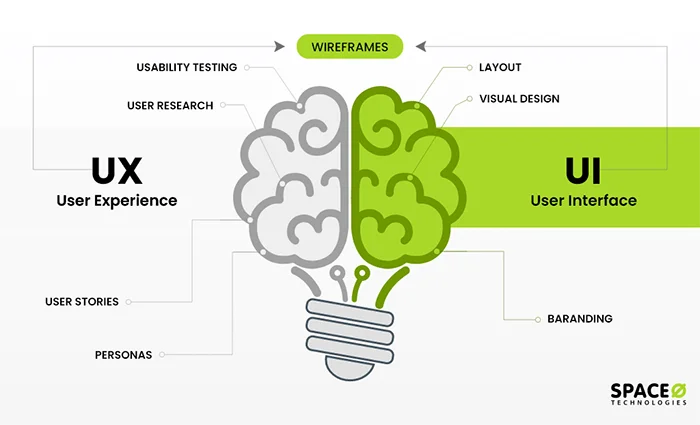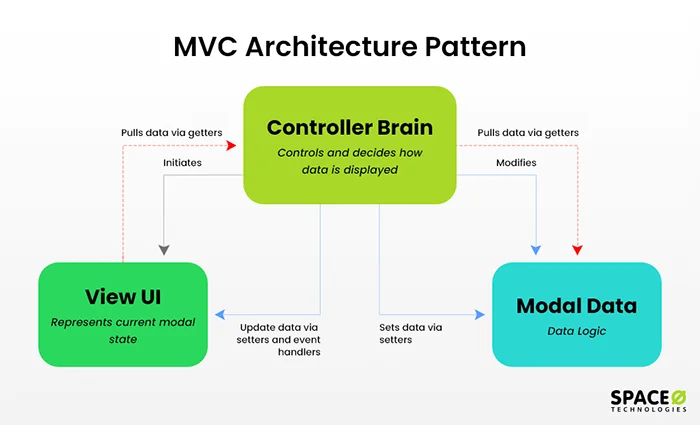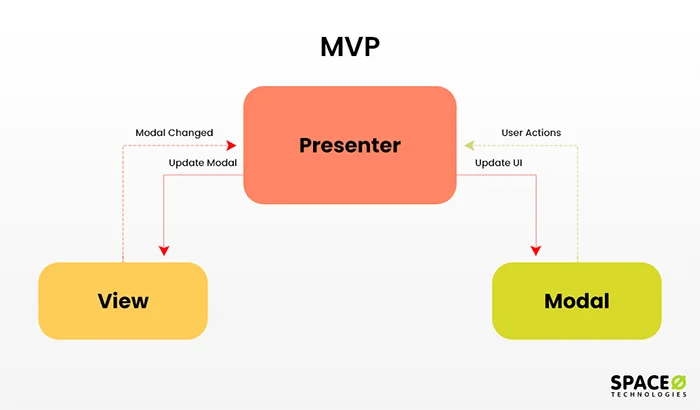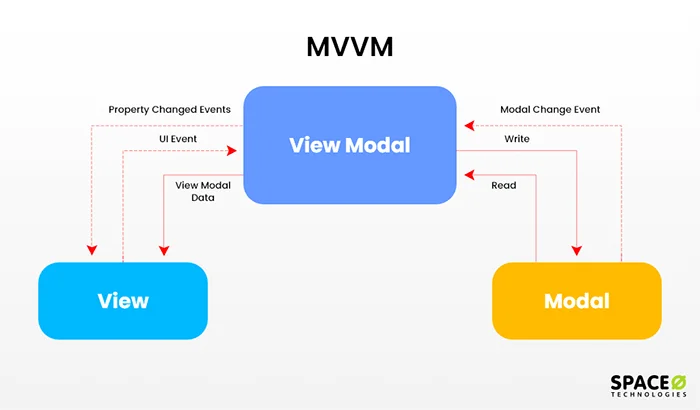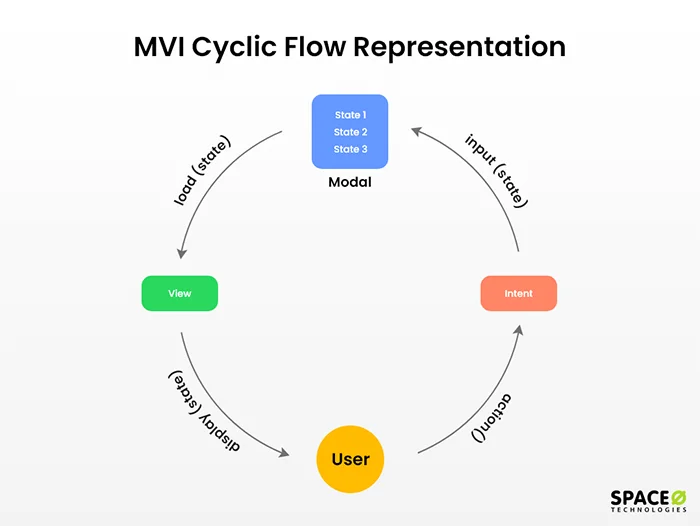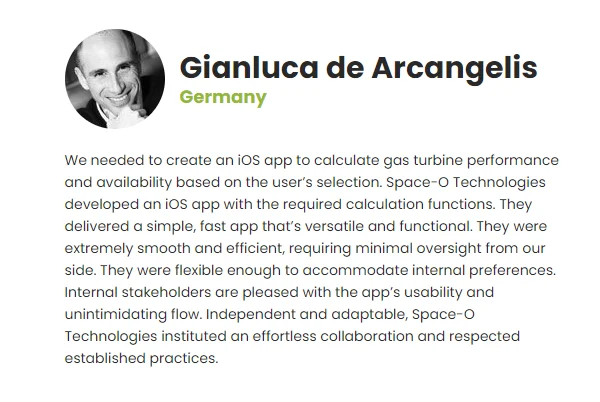Before constructing a building, the architect creates a blueprint to ensure loophole-free construction.
The same procedure is followed while building a mobile application. It is best to follow the mobile app architecture; once achieved, move to the development stage.
Only by following the right architecture, you can succeed in mobile app development and gain plenty of mobile app downloads. You might be surprised to know, that in 2022 alone, mobile app downloads have touched the mark of 255 billion globally.
Mobile app architecture helps a lot while building a featureful mobile app as per the industry standards.
Here are some of the challenges mobile app architecture solves.
- As your mobile app increases in size, it requires functionality and features, therefore mobile app architecture takes care of the scalability of your mobile app.
- Selecting the proper app architecture (MVC, MVVM, MVI) will help you to solve complex business problems in an effective way. Because of the following reasons.
Easier to understand
Easier to test
Easier to change
- Good mobile architecture is the base of a well-designed mobile app that offers an excellent user experience.
Above you have learned about the challenges mobile app architecture solves, next we will discuss the layers, key principles, examples, and patterns of mobile app architecture.
Table of Contents
What is the Mobile App Architecture?
In short, prior to creating an app from scratch, it is essential to follow the proper mobile architecture. As the mobile app architecture is the roadmap to permit best practices during mobile app development. There are 3 core layers of mobile app architecture, which we will discuss in the next section.
Which are the layers of mobile app architecture?
There are 3 core layers of mobile app architecture, which we will discuss in the next section.
- Presentation layer
- Business layer
- Data layer
What are the Layers of a Mobile App Architecture?
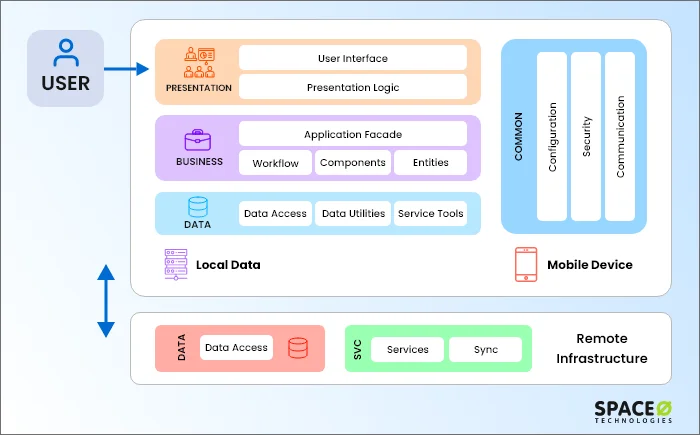
A good mobile app architecture diagram contains the below mentioned layers, which is also known as three-layer architecture.
| Mobile App Architecture Layers | Quick Overview of Core Mobile App Architecture Layers |
|---|---|
| Presentation Layer | This layer is focused on the user interface and UI process of the application. |
| Business Layer | In the business layer, the developers write code of specific business logic. |
| Data Layer | Securely managing and storing data is the responsibility of the data layer. |
This multi-tiered architecture represents the software development rules. Therefore, your team needs to develop each app element separately and combine them to make it work seamlessly.
Even dealing with complicated issues such as increased code readability makes the custom mobile application development more accessible and allows multiple developers to work simultaneously. Now, let’s understand how each of these layers works.
Presentation Layer
The presentation layer helps to present the mobile app to the end-user. While designing the presentation layer, the goal of developers should be user-oriented. It should be targeted toward user experience. The base of the presentation layer is the user interface (UI) and user experience (UX).
Example of Presentation Layer
When you open the Facebook app, you will see a login form, after login, you can directly interact with the dashboard. The presentation layer helps to show the UI/UX part of the mobile app.
Business Layer
The business layer is known as the core part of the mobile app. In business, back-end developers implement the business logic. Even the business layer contains solutions to the specific problems and shows the different elements such as data caching, logging, data validation, and exception management.
Example of Business Layer
Have you ever used LinkedIn to search for a job location or company profile? The business layer helps users to fetch those details directly from the app’s database.Data Layer
A data layer is made up of JavaScript objects utlised to share information from your website to the Tag Manage container. Basically, the data layer stores the data in the database then comes the business layer which will implement logic in that data, and ultimately it will be switched to the presentation layer which will show you the final output on your screen.
The data layer focuses on safety, which includes data access components, utilities, and service agents. Also, it should meet the application requirements and offer secure and efficient data transactions. Data layers can be easily modified depending upon the business requirements, as flexibility is one of the data layers’ strong suits.
Example of Data Layer
Web analytics tracking is a common example of a Data Layer. You might have a Data Layer that feeds visitor data into your analytics platform. This data is frequently unavailable in the presentational layer, or even in the markup.Portability – Make Your App React to Environmental Changes
Portability shows how the system behaves to a certain environmental change. Due to technological and market demand, frequent changes in the mobile app environment happen. Servers, databases, and other systems are affected as a result of these changes.
A good mobile application architecture ensures that the system is portable enough to respond to these changes while reducing impact.
Maintainability – Reduce the Efforts and Complexity of the App
There is always a need for mobile application maintenance when the requirements consistently change in the environment. The maintainability includes bug fixes, app performance enhancement, and upgradability according to technological changes.
A good mobile application architecture ensures the high maintainability of a mobile application. It decreases the time and effort required to implement a change, which benefits developers.
Reusability – Build Faster and Structured App
A smart app architecture must recognize that, in order to speed up the development of mobile apps, it is crucial for the components and protocols to be reused during the updates or redesign phase.
The architecture should be flexible enough in case there is a need for reusability in the app development cycle.
Security – Make Your App Robust
Data security is recognized as a non-functional requirement of an application. Encryption, HTTPS is a highly utilized method in data security. Wireless networks, cloud-based servers, and business websites are some of the well-known entry points for hackers. Overall, the aim of mobile application security architecture is to protect the data which is stored by the mobile app.
It should also sync in any security ecosystem by making the stored data completely encrypted. The following table will show you the list of security compliance and its importance.
Compliance Importance GDPR (General Data Protection Regulation) GDPR protects against unauthorized data collection, loss, damage, and destruction. PCI-DSS (Payment Card Industry Data Security Standard) PCI-DSS helps businesses to develop a secure network, as well as consistently maintain tested systems, and vulnerability programs. Example of Data Breach
- Due to the phishing attempt done by the hackers, 3 billion Yahoo users were compromised in 2013.
- eBay also saw the breach in 2014, where multiple users’ passwords were compromised. In its response, the company emailed each user and suggested changing their passwords immediately.
Performance
Quick and error-free mobile apps are the first choice of any user. However, if your mobile app takes a lot of time to start, chances are that the user will abandon your app. Therefore, a well-structured architecture should be followed in a way that meets each of the user’s expectations clearly. Firebase Performance Monitoring is a free tool that is utlised to check the performance of your Android, iOS, and web apps.
At this stage, you will be required to understand the technicalities of app designing depending on your app development lifecycle.
Which Points Impact the Performance of the Application?
Here are the 3 main points which directly affect the app performance.
- Application Design
It is essential to pay attention to optimized code, poorly configured network infra, and effective code algorithms. Otherwise, it will be difficult for you to achieve the performance of your mobile app.
- Efficient Memory Management
It is essential to avoid fragmentation of the memory and prevent any memory leakage.
- The Complexity of the Application
The app’s complexity includes checking different components and managing your app completely. As all the app components work together, it becomes challenging to monitor different parts of the app at once.
- Application Design
MVC

Prior to understanding MVC, you need to be clear about why it is used in the first place.
There are various types of software. Apart from embedded systems and time-sensitive apps, it is suggested to divide each part to maintain the apps easily.
Here MVC comes into the picture and separates the software components into the 3 core parts.
- The Model handles the app logic, for example, it determines what data to save, and how that data should respond to commands, and so on.
- The View determines how the app’s data is presented. In short, the elements user sees on their screen. The data will be directly displayed from the Model.
- The Controller handles user input. This section of the programme waits for user input before informing the other two portions of the programme to make the necessary adjustments.
Let’s understand the MVC with an example of the spreadsheet program.
- The “Model” will include the current values of the data in the spreadsheet
- The “View” portion would use data from the Model section to show parts of the spreadsheet on the screen (possibly not all of it, if the spreadsheet is too big).
- The “Controller” part will control the user’s mouse clicks and keyboard pushes, translating them into Model and View component commands. It would also require knowledge of the View in order to determine, for example, which cell the user selected.
MVC platform also helps to build SEO-friendly web apps. With MVC, it becomes effortless to divide and organize mobile or web application logic into enterprise-level apps. Therefore, it is crucial to understand web application architecture as well.
Components Explanation Model It is the data layer consisting of Model objects, persistence, parsers, networking code, and managers. View The User Interface layer is known as the View. It shows the data and maintains the track of user actions so that the Presenter can be easily notified. Controller It is a mediator which transmits the message with an abstraction using a protocol. Choosing architecture always depends upon what you are designing.
When to Use MVC Architecture?
- If you are designing a static site, there is no need to use MVC architecture.
- If you are working with an application having a different model layer (data part of the app), or a different view layer (user interface and presentation part), it is recommended to use MVC architecture.
- Example – Amazon.com – all the product pages are exactly the same, but it only renders differently due to the database.
When Not to Use MVC Architecture?
- If your mobile app doesn’t support a different model layer (for example a static app) or a different view layer (example: CMD tool) then don’t use MVC. Most of the applications apply dynamic behavior to clearly define models and views, therefore MVC fits perfectly well in the majority of the apps.
MVP

Model-View-Presenter (MVP) is an alternative to the MVC framework that Android developers have begun to use. Because it gives modularity, testability, and a codebase that is easier to manage. The Presenter works with the Model and View separately and shows the changes as needed. The table below explains the layers of MVP.
Components Explanation Model A data-storage layer. It is in charge of domain logic (real-world business rules) as well as establishing communication with the database and network layers. View The UI (User Interface) layer is the View. It visualizes the data and keeps track of the user’s actions so that the Presenter can be notified. Presenter Gets data from the Model and decides what to show using the UI logic. It keeps track of the View’s status and reacts to the user’s input notifications from the View. MVVM

MVVM refers to the Model View ViewModel. It is a client-side design pattern. To help you achieve “Separation of Concerns”, MVVM helps you to guide the design and structure of your code.
MVVM is a different approach to MVC in that it does not require you to put business logic in a view or a controller, as MVC does not specify where that logic should go.
Google and Jetpack have recommended MVVM for custom Android application development out of all the other Android app architectures.
MVVM architecture is preferred when there is a need to develop large scale apps. As the architecture is highly testable, extensible, and has a pluggable framework.
Ultimately, what MVVM does is help you reduce the code in your view controllers, and modularize the code and its testability.
Below are the core layers of MVVM.
Components Explanation Model This layer is in charge of the data sources’ abstraction. To retrieve and save data, the Model and ViewModel collaborate. View This layer’s function is to tell the ViewModel about the user’s action. ViewModel ViewModel separates the development of a GUI (graphical user interface) using GUI code or markup language. MVI

MVI stands for Model-View-Intent, it is one of the latest architecture types for developing Android apps. Also, it is an integral part of MVVM architecture.
Basically, MVI is an evolution over MVVM to control the update of ViewModel’s state.
MVI follows a unidirectional and cyclical nature because of the Cycle.js framework. This work of MVI stands out from other architecture types such as MVC, MVP, and MVVM.
Apart from that, due to the lack of state management, view rendering with business logic gets disordered at times. Also, due to state crisis business logic, UI rendering may get tangled. Check how MVI helps to avoid these types of scenarios.
- To have a single source of truth, state management must use immutability
- The data flow will be unidirectional
- Easily reuse code
MVI offers decoupled architecture pattern, as it solves the following problems.
- It lowers the number of edge cases.
- It is a solution to the State Problem.
- It upholds the principle of single responsibility (refer to S.O.L.I.D Principles).
You have learned about the Android architecture types, next, you will know the different pattern types of iOS mobile architecture.
MVC – Most Preferred Architecture Type
The goal of choosing the best architecture is to save money and time when it comes to development. MVC is the default architecture used by developers for designing macOS, iOS, and watchOS. As mobile apps having MVC architecture are more extensible.
React Native, Flutter, Ionic are some of the well known frameworks to build iOS apps. You can know more about iOS design patterns which help to enhance the app design and make the mobile app more powerful. The MVC architecture pattern can be divided into 3 categories which are mentioned below.
Components Explanation Model It includes logical operations of the data and the data which is stored locally on a browser. View View displays the data to users and includes the essential functionalities for users to work with it. Controller It is considered a main part of the architecture, it helps to build a connection between Model and View. MVVM – Well Known in the Industry
To let you know the secret MVVM is another well-known architecture pattern for building iOS apps.
In short, MVVM is based on the MVC module design. Overall, it is dependent on the MVC module design. The architecture is dependent upon these 4 principles.
- Simplicity
- Blendability
- Designability
- Testability
Our iOS developers use MVVM architecture to develop iOS apps, as this architecture makes the UI and block building easier. It is easier to unit test in ViewModel in comparison to event-driven code.
VIPER – Build Apps with Clean Architecture
VIPER is a clean design for an iOS application that includes 5 components:
- View
- Interactor
- Presenter
- Entity
- Routing
It is built from scratch to provide the components for the application’s use cases. Due to having different components, VIPER is quite challenging to start. The following includes the components and explanation of VIPER architecture.
If you are working on a complex project which requires careful consideration and development, choose VIPER.
Components Explanation View The basic function of a View is to collect inputs and display data as desired by the user. Interactor It contains business logic that is based on the per-use scenario. Presenter It includes the View logic and state, and it refreshes the View in response to the interactor’s commands. Entity The Model that interactors employ is called an app’s entity. Routing The router determines which View is displayed to the user and which View will be displayed next. Acquiring an understanding of iOS app architecture, Mr. Gianluca wanted to build fast and efficient iOS apps for his business. He reached out to us and shared his app idea to calculate gas turbine performance. Our iOS mobile app developers understood his requirements and built an efficient mobile app. Here is the complete testimonial of our client.

- Apache Cordova
- Ionic Capacitor
- Instagram – This app is developed in React Native to be accessible on mobile and web altogether.
- BMW – BMW switched to the Flutter framework, which is Google’s cross platform framework. By applying Flutter, the team could implement features in less time in both version of the application.
Want to Build a Custom Mobile Application?
Talk to us. We have expertise in developing mobile apps across all industries.

Next, you will know the key foundation of building dynamic and user-friendly mobile applications.
What are the Key Mobile App Architecture Principles?
| Principles | Quick Overview of Mobile App Architecture Principles |
|---|---|
| Portability | The system should be portable enough to react to all the technological and market changes. |
| Maintainability | As per the market demand, the app component should be modified. Therefore, maintainability should always be there. |
| Reusability | Faster and structured app development process leads to reusability. |
| Security | Any data which is consumed by the application should be secured. The stored data should be encrypted. |
| Performance | The app should respond quickly and retrieve data faster without lagging. |
Let’s discuss each of the above-mentioned principles in detail.
Mobile App Architecture Example
Best iOS or Android mobile application architecture is built by adhering to the one rule, which is to make the development and maintenance of mobile apps simpler and more efficient. Please note that a program with suitable mobile app architecture is effortless to expand, modify, test, debug, and understand.
For example, the well-structured mobile architecture is a perfect fit for enterprise-level projects with sizable budgets. Being a general architecture, it permits the installation of different plug-ins and troubleshoots the issues quickly. However, it should not be built using frameworks rather the code needs to be written from the base.
The following clean architecture is designed by American software engineer and best-selling author Robert Martin.
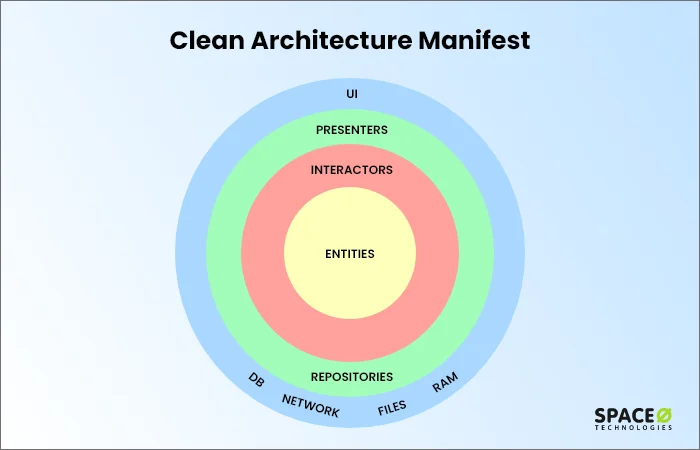
There are four layers explained in the diagram, blue layer, green layer, red layer, and yellow layer. Each circle describes different areas of software. The outmost blue layer is considered to be the lowest level of software. The deeper we move in, the deeper the layers are less likely to change.
If you look at the sphere, you can check that business domain entities are the inner core, and UIs, APIs DBs, or external devices are the public shell.
The use cases will be called from the Presenters, Controllers, or Gateways. If you look at the system from the outside, first you move into the system from UI, DB, and devices, then call the use cases, and at the end, it calls the business domain entities.
As the layer becomes wider, it also becomes concrete and unchangeable. Every layer is dependent on the layer above it. Next, learn about the different mobile architecture patterns.
Android Mobile Architecture Patterns
It is not possible to implement core logic in activities or fragments when working on a real mobile application whose nature is dynamic and may increase its features and functionalities at times.
Architecture patterns are used to divide the concerns in the project’s code and provide it with a modular design (separated code components).
Selecting the right mobile app architecture is crucial. Therefore, we have explained the list of architecture types and their explanations so you can make the appropriate decision.
| Architecture Types | Explanation | Use Case of Different Mobile App Architectures |
|---|---|---|
| MVC | MVC is the oldest Android app architecture which includes 3 layers: Model, View, and Controller. | MVC is ideal for building small-scale apps which don’t require upgrades. |
| MVP | The MVP pattern is the Android app architecture’s second version. The MVP solves the challenges of MVC and provides effortless ways to structure the project codes. | MVP is ideal for building medium size apps that require no scalability. |
| MVVM | The MVVM pattern is the third version of Android architecture. The Android team propose this design approach when they released the Android architecture components. | MVVM is well suited to the technology and allows you to keep your code tidy and maintainable. |
| MVI | Model-View-Intent is considered one of the latest Android mobile application development architectures and follows a cyclical and unidirectional nature. | If you are planning to make an app scalable in the future with easy testability then choose MVI architecture. |
Let’s discuss each architecture type in detail.
iOS Mobile Architecture Patterns
In iPhone app development, iOS mobile architecture plays an important role. To build any iOS application, iOS developers are required to follow certain guidelines for a specific architecture. It permits them to write clean and maintainable code for future business requirements.
Planning to Build a Custom iOS Mobile App?
Talk to us. More than 2800 iOS apps have been built by our iPhone app developers. Validate your app idea from our tech professionals and get a customized quote.
Hybrid Mobile Architecture Diagram
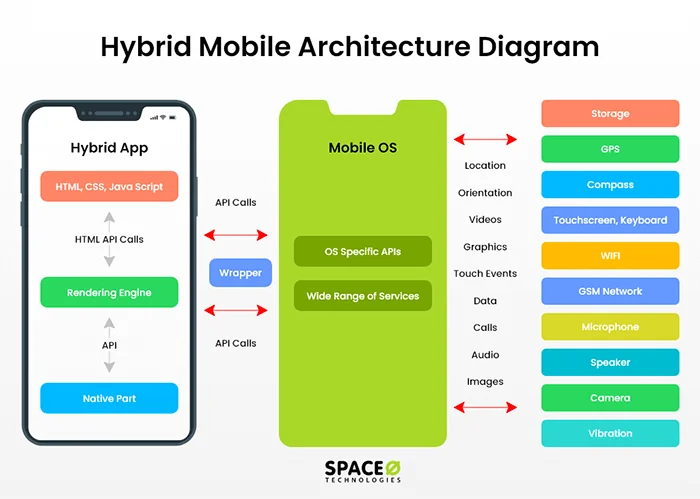
Hybrid apps can make use of native and web app solutions altogether. Our app development utlise MVVM architecture while developing hybrid apps. Hybrid apps utilize native apps as shells for the back end and HTML, CSS, and JavaScript for the front end. To access native platform features, Hybrid applications utilize the following plugins.
Along with that, hybrid mobile apps can be developed in a short span of time, and it is accessible on a variety of platforms and is easy to update. However, it is not appropriate for building complex, interactive, and feature-rich mobile apps.
Well known Apps Which Uses Hybrid Framework
We have discussed important points about choosing the mobile app architecture, below we have answered important questions related to app architecture that you need to check out.
FAQ About Mobile App Architecture
What is the difference between mobile app architecture and mobile tech stack?
Mobile app architecture gives a clear roadmap consisting of different patterns (MVC, singleton patterns) to design and build an app.
Whereas, the tech stack is the combination of different technologies (PHP, and Python) to develop and run a website or an application. The tech stack is the combination of a database, front-end and back-end tools, and frameworks.
What is an app architecture diagram?
An application architecture diagram is a graphical representation of the app’s architecture that supports the identification of applications, sub-applications, components, databases, services, and other elements, as well as their relationships.
Take Advantage of Mobile App Architecture for Your App
In this blog, we have covered essential information about mobile app architecture such as different architecture principles, examples of mobile app architecture, Android and iOS design patterns. To build powerful and industry-standard mobile apps, different mobile app architecture diagrams such as Android, iOS, and hybrid have been explained.
Being a leading mobile app development company in the USA, consult with us to choose the suitable mobile app architecture for your mobile app. Our team of experienced app developers will help you to validate your idea, and help you to solve any queries regarding mobile app development. Book your free consultation by reaching out from the contact us form.
